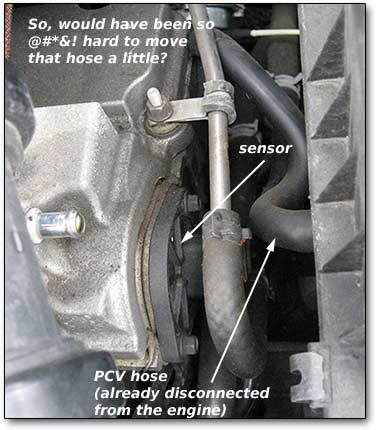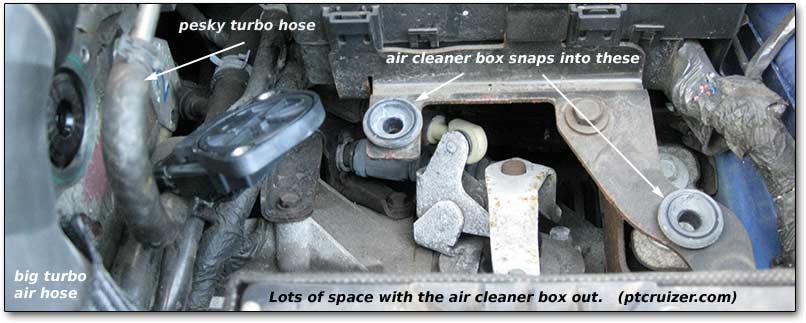What Size Bolts Does A 2001 Pt Cruiser Camshaft Sensor Take
Chrysler PT Cruiser cam sensor replacement: standard and turbo
We are not responsible for the accuracy of the information or opinions presented hither, or for any consequences of taking activity based on them. Continue at your own hazard.

When the cam position sensor (or camshaft position sensor) starts to go, it is commonly signalled past the Check Engine light, a code of P0340 being set, and the Limp In (or Limp Abode) manner being activated. The engine will not go over ii,500 rpm and those with manual transmissions will striking the rev limiter. Clearing the lawmaking may temporarily help but somewhen it volition exist prepare over again.

The issue is sometimes a matter of wiring, then visually checking the wires as they get dorsum to the computer from the camshaft position sensor is a good first step. However, the sensor itself is decumbent to failure later on a mere 5-10 years, and just costs $35 at the local parts shop. Dealer parts may toll more.

Replacement is piece of cake on a standard, non-turbocharged PT Cruiser and only a piddling harder on a turbocharged car. We did this repair on a PT Cruiser GT with the turbo two.iv (full pressure). Practice it when the engine is cold (that is, not when it has been running recently). As LisaLee pointed out, information technology'due south a adept idea to disconnect the negative battery terminal get-go, every bit with all engine work.
 Showtime, become out your tools. You volition demand an 8 mm socket (with an extender if you take a turbo engine), a torque wrench measured in inch-pounds, and, for turbo owners, a direct 8 mm wrench. You also demand a apartment-bladed screwdriver, and, of course, a replacement sensor.
Showtime, become out your tools. You volition demand an 8 mm socket (with an extender if you take a turbo engine), a torque wrench measured in inch-pounds, and, for turbo owners, a direct 8 mm wrench. You also demand a apartment-bladed screwdriver, and, of course, a replacement sensor.
If you have a turbo 2.iv, unscrew the turbocharger air feed (it'southward the huge hose on top of the engine) and gently pull it off of the metal pipe on top. Remove the small air hose from the eye of the pipe and gently push it bated, only a few inches to your left (assuming you're leaning over the grille). Don't worry about removing the hole hose.
Open the air cleaner holder by undoing the two snaps, then loosening the air pipe fastener with the screwdriver (or a socket wrench) and gently pushing the hose off. Take out the filter, unplug the little hose on the left hand side (assuming you lot are leaning over the grille and radiator), and wiggle/pull the air cleaner box up.
The air cleaner box is not bolted in, simply you should have note of how it'southward positioned now, because you lot'll need to push it dorsum in later on. It should pop out with a little muscle/wiggle.
Don't be besides concerned if there'south a footling oil on the lesser of the air cleaner housing. That probably came from the crankcase ventilation system — which is also why you have that little hose that you had to pop out.
Once you've done this, you lot will come across and exist able to hands access the camshaft position sensor ... if you lot don't have a turbo car. Information technology'southward right on the side of the engine well-nigh the summit and is pretty unmistakeable as the only great big sensor attached to the engine.
If you do take a turbo engine — a GT or a PT Cruiser Limited with the low-cal-pressure turbocharger — you volition see that the sensor is nicely blocked by a serious-looking metal pipe attached to a rubber hose. You lot could take that off simply I didn't because it appears to carry oil or coolant and I don't want to mess with those unnecessarily. That's why the turbo people need the straight wrench.

Now, use a small screwdriver to push the orange tab over to the side; you tin can slide the screwdriver underneath the tab and plough it to move it over. Then press the black tab and pull the wiring harness off. If your engine is warm, be careful about where the harness falls then it doesn't rest on anything hot.
The next pace is to remove the sensor itself. For nonturbo people, simply accept out the two screws with the 8mm socket wrench. For turbo people, take out the one screw that you can reach that way (the far spiral) with the 8mm wrench and extender, to avoid agonizing the hose. For the other spiral, employ the straight wrench and your patience.
The sensor will have some oil in information technology. This is normal, and the replacement sensor should come with a replacement seal in the box to go on the oil in. Make clean the area around the sensor, being very careful not to become anything in the exposed surface area normally covered by the sensor. Then insert the gasket into the sensor and put information technology in. If, later, you go an oil leak, y'all can carefully apply RTV to seal information technology — only, again, avoid getting any strange material into that exposed bit of engine.
Put in the new sensor, checking the service transmission for the correct torque. The catchy part here is that turbo owners must either become rid of that pesky hose or employ the straight wrench to get the experience of the tightness of the spiral they put in with the torque wrench, and then tighten with the straight wrench. Either fashion, there'southward not a lot of pressure level involved —115 inch-pounds (12 Nm). This is of import, because the cam sensor apparently is besides used as a cam tensioner.
Everything should become back together easily. Clear the codes either with bombardment disconnection or, preferably, a code reader — a concatenation store or dealer may be willing to do this for y'all. Check subsequently a exam drive to make sure the sensor is not leaking oil. If the problem re-occurs, there may be a wiring issue.
Other PT Cruiser repairs
Comments? Additions? Utilise this form over at allpar!
![]()
What Size Bolts Does A 2001 Pt Cruiser Camshaft Sensor Take,
Source: https://ptcruizer.com/pt-cruiser/cam-sensor-repair.html
Posted by: rouseingesed.blogspot.com


0 Response to "What Size Bolts Does A 2001 Pt Cruiser Camshaft Sensor Take"
Post a Comment